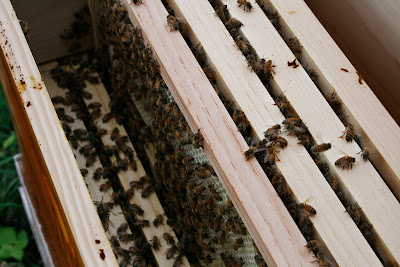About ten days ago I had placed an Api Life Var wafer onto my hive (broken into four separate pieces) along with a section of pollen patty. I have now gone back into my hive to replace the wafer with a new one and to check on my bees. When I took off my inner cover, I was not overly pleased. The pollen patty that I had put onto my hive was severally infested with small hive beetle larva and I had to go on a killing spree, killing about 20 beetles. I do have to admit that most of the beetles were hiding in corners but with the amount of larva and beetles that were in the hive top feeder, I took it off and set it to the side to deal with later.
 |
| Pollen Patty with Hive Beetle Larva |
 |
| Hive Beetles Hiding in a Corner |
I had only added half of a patty thinking that my bees would devour through it in no time but now that it is filled with larva, it is trash.I was told that I had added too much of the pollen patty and that if I were to continue feeding with them, I only needed to add small chunks at a time.
Going deeper into my hive seemed to be a lot better. Still a lot of bees and a good brood pattern. When I got down to the bottom brood chamber, the wafer I had broken up and placed on my hive was completely gone. Broke up a new wafer and applied it to the four corners of the brood chamber and closed up my hive.
 |
| Broken Wafer on the Corner of a Brood Chamber |
Another 7 to 10 days and I apply my last wafer for mite treatment. Everything is looking good except for the abundance of small hive beetles.
I hate dealing with Pests!




























